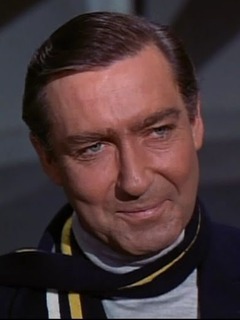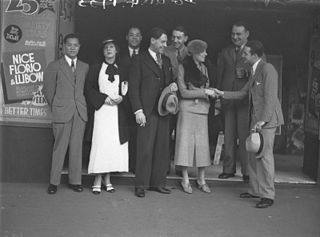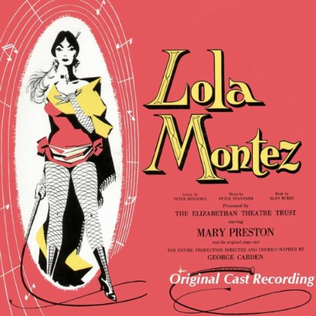Related Research Articles

Vivien Leigh, styled as Lady Olivier after 1947, was a British actress. She won the Academy Award for Best Actress twice, for her performances as Scarlett O'Hara in Gone with the Wind (1939) and Blanche DuBois in the film version of A Streetcar Named Desire (1951), a role she had also played on stage in London's West End in 1949. She also won a Tony Award for her work in the Broadway musical version of Tovarich (1963). Although her career had periods of inactivity, in 1999 the American Film Institute ranked Leigh as the 16th-greatest female movie star of classic Hollywood cinema.

Frederick George Peter Ingle Finch was an English-Australian actor of theatre, film and radio.

Robert Guy Newton was an English actor. Along with Errol Flynn, Newton was one of the more popular actors among the male juvenile audience of the 1940s and early 1950s, especially with British boys. Known for his hard-living life, he was cited as a role model by the actor Oliver Reed and the Who's drummer Keith Moon.

The Imaginary Invalid, The Hypochondriac, or The Would-Be Invalid is a three-act comédie-ballet by the French playwright Molière with dance sequences and musical interludes by Marc-Antoine Charpentier. It premiered on 10 February 1673 at the Théâtre du Palais-Royal in Paris and was originally choreographed by Pierre Beauchamp.

Guy Doleman was a New Zealand born actor, active in Australia, Britain and the United States. He is possibly best remembered for being the first actor to play Number Two in the classic cult series The Prisoner.
Lloyd Berrell was a New Zealand actor who played Reuben "Roo" Webber in the original Sydney production of Summer of the Seventeenth Doll. He worked extensively in Australian radio and theatre, appearing in a large portion of the films being shot locally at that time. He also starred in the original stage production of Sumner Locke Elliott's Rusty Bugles as well as numerous productions for the Mercury Theatre.
Creswick Jenkinson was an Australian writer, producer and director. As a screenwriter, he wrote the film Captain Thunderbolt (1953) as well as episodes of the TV series Skippy the Bush Kangaroo, Autumn Affair and Motel.
Kurt Kaiser, better known as Sydney John Kay, was a German-born composer, musician and theatre entrepreneur.
The Mercury Theatre was an Australian theatre company that was co-founded by Peter Finch and existed from 1946 to 1954. It was named after the American Orson Welles' theatre company of the same name.

The New Tivoli Theatre, Sydney, previously known as the Adelphi Theatre and the Grand Opera House, was a theatre and music hall at 329, Castlereagh Street, Sydney, Australia, which was long at the heart of the Tivoli circuit.

Tamara Tchinarova, also known as Tamara Finch, was a Romanian-born émigré Russian and French ballerina who contributed significantly to the development of Australian dance companies and was a Russian/English interpreter for touring ballet companies. She was a dance writer and author, as Tamara Finch, of a number of non-fiction books. She was the first wife of actor Peter Finch.
Harold Frederick Weaver Hawkins (1893–1977) was an English painter and printmaker working with the techniques of etching, monotypes, linocuts and woodcuts. He specialized in "ambitious, sometimes mural-sized, modernist allegories of morality for an age of atomic warfare and global over-population." He was active from 1923 to 1972.

Ronald "Trader" Faulkner was an Australian actor, raconteur and flamenco dancer, best known for his work in the UK on the stage and television.
Another Threshold is a 1942 Australian propaganda short film directed by Ken G. Hall and starring Peter Finch.

Lola Montez is a 1958 Australian musical. It was written by Alan Burke, Peter Stannard, and Peter Benjamin and focuses on four days of Lola Montez visiting the Ballarat Goldfields.
The Square Ring is a 1952 play by Ralph Peterson.
Jennifer Hagan is an Australian actress who was the acting tutor at the National Institute of Dramatic Art from 1991 until 1997. For three decades she was a leading player with professional theatre companies throughout Australia notably for the Old Tote Theatre Company and Sydney Theatre Company. Hagan retired in 2020. Her work was characterised by precision, energy and humour.
False Colours is a 1935 Australian play by Frank Harvey.
Peter Finch is an Australian actor whose career spanned more than forty years.
The Imaginary Invalid is a comédie-ballet by Molière.
References
- ↑ Stephen Vagg, 'Finch, fry and factories: a brief history of Mercury Theatre', Australasian Drama Studies, 50, Apr 2007, 18–35
- ↑ "Music and Drama "A Cry of Players"". The Sydney Morning Herald . No. 33, 870. New South Wales, Australia. 13 July 1946. p. 6. Retrieved 12 November 2023– via National Library of Australia.
- ↑ "Advertising". The Sydney Morning Herald . No. 34, 553. New South Wales, Australia. 18 September 1948. p. 11. Retrieved 12 November 2023– via National Library of Australia.
- ↑ "Meeting In Coffee Lounge". The Sun-herald . New South Wales, Australia. 15 August 1954. p. 24. Retrieved 12 November 2023– via National Library of Australia.
- ↑ "Sydney Diary". The Sun . No. 12, 036. New South Wales, Australia. 24 August 1948. p. 9 (Late Final Extra). Retrieved 12 November 2023– via National Library of Australia.
- ↑ Faulkner, Trader (1979). Peter Finch. p. 163.
- ↑ Dundy, Elaine (1979). Finch Bloody Finch. pp. 126–134.
- ↑ ""La Malade Imaginaire."", The Bulletin, John Ryan Comic Collection (Specific issues)., 69 (3578), Sydney, N.S.W: John Haynes and J.F. Archibald (published 1880), 8 Sep 1948, ISSN 0007-4039, nla.obj-552677577, retrieved 13 November 2023– via Trove
- ↑ "Actor to Appear in Lunch-Hour Play". The Daily Telegraph . Vol. IX, no. 45. New South Wales, Australia. 19 September 1948. p. 6. Retrieved 12 November 2023– via National Library of Australia.
- ↑ "Moliere At Lunch-time". The Sydney Morning Herald . No. 34, 555. New South Wales, Australia. 21 September 1948. p. 2. Retrieved 12 November 2023– via National Library of Australia.
- ↑ "Repertory Plans". The Sunday Herald (Sydney) . No. 160. New South Wales, Australia. 17 February 1952. p. 9. Retrieved 12 November 2023– via National Library of Australia.
- ↑ "Famous Aust. Theatre Stars to Visit Bathurst". The National Advocate . Bathurst, NSW. 7 October 1948. p. 5. Retrieved 25 July 2015– via National Library of Australia.